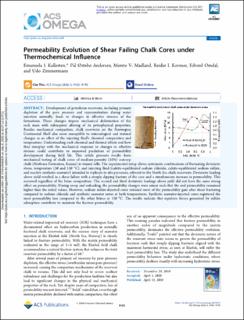| dc.contributor.author | Kallesten, Emanuela Iedidia | |
| dc.contributor.author | Andersen, Pål Østebø | |
| dc.contributor.author | Madland, Merete Vadla | |
| dc.contributor.author | Korsnes, Reidar Inge | |
| dc.contributor.author | Omdal, Edvard | |
| dc.contributor.author | Zimmermann, Udo | |
| dc.date.accessioned | 2021-05-06T07:09:47Z | |
| dc.date.available | 2021-05-06T07:09:47Z | |
| dc.date.created | 2020-04-10T14:26:17Z | |
| dc.date.issued | 2020-04 | |
| dc.identifier.citation | Kallesten, E.I., Andersen, P.Ø., Madland, M.V. et al. (2020) Permeability evolution of shear failing chalk cores under thermochemical influence. ACS Omega, 5, 9185-9195. | en_US |
| dc.identifier.issn | 2470-1343 | |
| dc.identifier.uri | https://hdl.handle.net/11250/2753787 | |
| dc.description.abstract | Development of petroleum reservoirs, including primary depletion of the pore pressure and repressurization during water injection naturally, leads to changes in effective stresses of the formations. These changes impose mechanical deformation of the rock mass with subsequent altering of its petrophysical properties. Besides mechanical compaction, chalk reservoirs on the Norwegian Continental Shelf also seem susceptible to mineralogical and textural changes as an effect of the injecting fluid’s chemical composition and temperature. Understanding such chemical and thermal effects and how they interplay with the mechanical response to changes in effective stresses could contribute to improved prediction of permeability development during field life. This article presents results from mechanical testing of chalk cores of medium-porosity (32%) outcrop chalk (Niobrara Formation, Kansas) in triaxial cells. The experimental setup allows systematic combinations of fluctuating deviatoric stress, temperature (50 and 130 °C), and injecting fluid (calcite-equilibrated sodium chloride, calcite-equilibrated sodium sulfate, and reactive synthetic seawater) intended to replicate in situ processes, relevant to the North Sea chalk reservoirs. Deviatoric loading above yield resulted in a shear failure with a steeply dipping fracture of the core and a simultaneous increase in permeability. This occurred regardless of the brine composition. The second and third deviatoric loadings above yield did not have the same strong effect on permeability. During creep and unloading, the permeability changes were minor such that the end permeability remained higher than the initial values. However, sodium sulfate-injected cores retained most of the permeability gain after shear fracturing compared to sodium chloride and synthetic seawater series at both temperatures. Synthetic seawater-injected cores registered the most permeability loss compared to the other brines at 130 °C. The results indicate that repulsive forces generated by sulfate adsorption contribute to maintain the fracture permeability. | en_US |
| dc.language.iso | eng | en_US |
| dc.publisher | American Chemical Society | en_US |
| dc.rights | Navngivelse 4.0 Internasjonal | * |
| dc.rights.uri | http://creativecommons.org/licenses/by/4.0/deed.no | * |
| dc.title | Permeability evolution of shear failing chalk cores under thermochemical influence | en_US |
| dc.type | Peer reviewed | en_US |
| dc.type | Journal article | en_US |
| dc.description.version | publishedVersion | en_US |
| dc.rights.holder | © 2020 American Chemical Society | en_US |
| dc.subject.nsi | VDP::Matematikk og Naturvitenskap: 400::Kjemi: 440 | en_US |
| dc.source.pagenumber | 9185-9195 | en_US |
| dc.source.volume | 5 | en_US |
| dc.source.journal | ACS Omega | en_US |
| dc.identifier.doi | 10.1021/acsomega.9b04470 | |
| dc.identifier.cristin | 1805815 | |
| dc.relation.project | Norges forskningsråd: 230303 | en_US |
| cristin.ispublished | false | |
| cristin.fulltext | original | |
| cristin.qualitycode | 1 | |

